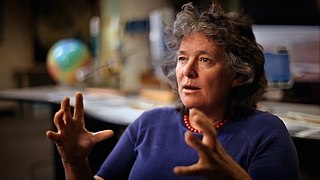
Lake Fryxell is a frozen lake 4.5 kilometres (2.8 mi) long, between Canada Glacier and Commonwealth Glaciers at the lower end of Taylor Valley in Victoria Land, Antarctica. It was mapped in the early 1900s and named during Operation Deep Freeze in the 1950s. There are several forms of algae living in the waters and a weather station located at the lake.

The Onyx River is an Antarctic meltwater stream which flows westward through the Wright Valley from Wright Lower Glacier and Lake Brownworth at the foot of the glacier to Lake Vanda, during the few months of the Antarctic summer. At 32 kilometres (20 mi) in length, it is the longest river in Antarctica.

Lake Hoare is a lake about 4.2 kilometres (2.6 mi) long between Lake Chad and Canada Glacier in Taylor Valley, Victoria Land, Antarctica. Its surface area measures 1.94 square kilometres (0.75 sq mi). The lake was named by the 8th Victoria University of Wellington Antarctic Expedition (VUWAE), 1963–64, for physicist Ray A. Hoare, a member of the VUWAE that examined lakes in Taylor, Wright, and Victoria Valleys.

Lake Bonney is a saline lake with permanent ice cover at the western end of Taylor Valley in the McMurdo Dry Valleys of Victoria Land, Antarctica.
Mark Dyurgerov was an internationally known glaciologist and Fellow of the Institute of Arctic and Alpine Research (INSTAAR) of the University of Colorado at Boulder. He was born in Moscow, Russia; both of his parents were engineers, and his mother was also a Russian poet.
Robert Earl Dickinson is an American meteorologist and geoscientist.

The Institute of Arctic and Alpine Research (INSTAAR) is a scientific institute that is part of the University of Colorado Boulder. Its research mission is to "[develop] scientific knowledge of physical and biogeochemical environmental processes at local, regional and global scales, and appl[y] this knowledge to improve society's awareness and understanding of natural and anthropogenic environmental change."

Frances "Fran" Bagenal is a Professor of Astrophysical and Planetary Sciences at the University of Colorado Boulder and a researcher in the fields of space plasmas and planetary magnetospheres.
Niwot Ridge is an alpine ecology research station located 65 km north-west of Denver in north-central Colorado. It is on the Front Range of the southern Rocky Mountains and lies within the Roosevelt National Forest. Niwot Ridge is 2,900 metres (9,500 ft) high.

Diana Harrison Wall is the Founding Director of the School of Global Environmental Sustainability, a Distinguished Biology Professor, and Senior Research Scientist at the Natural Resource Ecology Laboratory at Colorado State University. She is an environmental scientist and a soil ecologist and her research has focussed on the Antarctic McMurdo Dry Valleys. Wall investigates ecosystem processes, soil biodiversity and ecosystem services and she is interested in how these are impacted by global change. The Wall Valley was named after her in recognition of her research in the McMurdo Dry Valleys. Wall is a globally recognised leader and speaker on life in Antarctica and climate change.

Cristina Takacs-Vesbach is an American microbial ecologist conducting research on the productivity, diversity, and function of microbial communities living at the two extremes of temperature found on Earth-Antarctica's McMurdo Dry Valleys and Yellowstone National Park's thermal springs.

Louise Tolle Huffman is an American teacher with over 30 years of teaching experience with many years focused on polar science and climate studies, and has written educational outreach books and articles on Antarctica. She is the Director of Education and Outreach for the US Ice Drilling Program Office (IDPO), responsible for outreach efforts highlighting IDPO scientists and their research results.
John Thomas Andrews is a British-American geologist and professor emeritus of geological and atmospheric and oceanic sciences at the University of Colorado Boulder's Institute of Arctic and Alpine Research (INSTAAR), in Boulder, Colorado, USA.

John T. "Jack" Gosling was an American physicist, whose research in heliophysics focused on the large-scale structure and magnetic topology of the solar wind, coronal mass ejections, solar wind and geomagnetic disturbances, magnetic reconnection, collisionless shocks, and particle acceleration in space. Gosling most recently performed research at University of Colorado and was an Elected Fellow of the American Association for the Advancement of Science.
Tania Schoennagel is an ecologist who specializes in wildfires and insect outbreaks. She is a research scientist at the University of Colorado, Boulder and has been involved with INSTAAR since 2011.

Holly René Barnard is an American geographer and Associate Professor of Geography at the University of Colorado Boulder. She studies how vegetation impacts the dynamics and pathways of streams. In 2020 Barnard was awarded a $7 million National Science Foundation grant to set up a Critical Zone Observatory at the University of Colorado Boulder.
Katharine Nash Suding is an American plant ecologist. Suding is a Distinguished Professor of ecology and evolutionary biology at the University of Colorado Boulder and a 2020 Professor of Distinction in the College of Arts and Sciences.
Suzanne Prestrud Anderson is an American geophysicist who is a professor at the University of Colorado Boulder. Her research considers chemical weathering and erosion, and how it shapes the architecture of critical zones. She is a Fellow of the Geological Society of America and the American Geophysical Union.
Merritt Turetsky is American ecosystem ecologist who is a professor at the University of Colorado Boulder. She serves as Director of the Institute for Arctic and Alpine Research (INSTAAR). Her research considers fire regimes, climate change and biogeochemical cycling in Arctic wetlands. Turetsky is a member of the Permafrost Action Team (SEARCH), a group of scientists who translate and deliver science to decision-makers.
Elizabeth A. Barnes is an American climate scientist. Barnes is best known for her work and expertise on the use of statistical methods to understand the variability of Earth's short- and long-term climate. Her work is characterized by an integration of both physics and computer science approaches. She is a Fellow of the American Geophysical Union.











